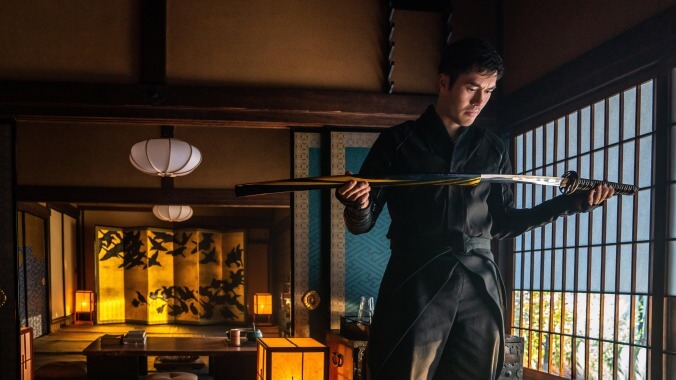Henry Golding plays Snake Eyes in a slick G.I. Joe origin story
Why is there a new G.I. Joe movie in 2021? And how is it this much fun?
Image: Photo: Paramount Pictures
Snake Eyes (Henry Golding) is a walking, talking origin story. He’s a cipher with only a boilerplate inciting incident to his name, which of course that incident handily yet nonsensically explains. The nickname comprises much of his personality; the rest is his nagging thirst for vengeance against the man who killed his father. Like his fellow just-barely-anti-hero Wolverine, Snake Eyes spends time as a drifter and gets tangled up with the yakuza in Japan. Unlike Wolverine, this character is difficult to picture as part of a bigger, grander adventure. Despite its subtitle, it would be easy enough to forget what, exactly, Snake Eyes is supposed to be prequelizing, if not for an innocent question that comes over an hour into the movie: “So what’s the deal with Cobra?”
Ah, there’s that subtitle: It’s G.I. Joe Origins, and it explains Snake’s rootlessness. He’s filling in backstory for a character who didn’t speak during his appearances in a couple of movies that came out nearly a decade ago, based on a toy line whose popularity peaked well before that. Somehow, Snake Eyes: G.I. Joe Origins not only exists but also heads into movie theaters at a time when plenty of big-budget productions have absconded for streaming. The director, Robert Schwentke, made the first Red and a couple of Divergents. All together, this might make Snake Eyes the world’s first 2014 nostalgia object.
As nostalgia, Snake Eyes feels like a failure, inspiring wistfulness about neither the mildly successful past films nor the Saturday morning culture that inspired them. (More devoted fans of the old cartoon series may disagree.) However, as a movie about hordes of ninjas drawing their swords and running at each other, it is a notable success. “New threats call for new strategies,” one character helpfully explains, and it’s true: The filmmakers bravely strategize against the threat of shameless franchise extensions not having enough ninjas.
Befitting his status as an action figure, Snake Eyes is relatively passive even in action. He wants revenge enough to insert himself into a dangerous conflict between the yakuza and a secret clan of protector warriors, but not so passionately that he makes any previous effort to track down his father’s killer himself. Drifting through odd jobs and fight clubs, he’s recruited to serve Kenta (Takehiro Hira), who promises to hand over the killer if Snake Eyes infiltrates the clan that once cast Kenta out. Snake Eyes obliges, ingratiating himself to the taciturn Tommy (Andrew Koji) and, less quickly, the wary Akiko (Haruka Abe). While receiving seemingly minimal training and taking three leisurely paced clan challenges, Snake Eyes cases the clan fortress for the enchanted object sought by Kenta. Eventually, it becomes clear that the groups are serving as proxies, of sorts, for the international terrorism-fighting organization G.I. Joe and their archenemies, Cobra. Each side has a famous ex-toy drop in, presumably to tease future adventures. That’s the best way to explain the 10 minutes or so of screen time afforded Samara Weaving as Scarlett, or the relative redundancy of Úrsula Corberó as the Baroness, formerly played with a bit more panache by Sienna Miller.
As for Snake Eyes himself, he was once played by Ray Park—a tough act to follow, at least physically. The movie ultimately doesn’t have a lot of credibility as a martial arts extravaganza, but Golding throws himself into it, as do the litany of stunt performers who make sure the bodies in motion look like actual bodies, not blurry video game avatars. Schwentke smooshes together various quirks of high-octane action directing—some shades of green that could be described as Off Tony Scott, enough low-angle shots for Michael Bay to shoot dozens of badasses exiting vehicles—and some of his moves come from the wait-what-just-happened school of close-up fight choreography. Yet there’s an eye-pleasing slickness to the whole enterprise, compared to the generic, often dispiriting slickness of Schwentke’s previous Hollywood work.
His new one is, to be clear, nonsense. Crucially, it’s also nonsense that really moves, and until the fiery climax, often feels like it’s moving through an actual physical reality, albeit a ridiculous one. The cab of a truck gets turned into a magician-style sword box. Characters scuffle on neon-lit rooftops. Mettle is tested via giant snakes. (Okay, that last one leans on the CGI.) The colors are rich and saturated; even the darker scenes have more texture than the digital cloud cover that hangs over so many blockbusters. Snake Eyes: G.I. Joe Origins doesn’t reach the giddy, earnest heights of something like Aquaman or a Wachowski project. It methodically sets up sequels—to be recast and released around 2030, judging by the Joes’ cinematic track record so far. But the dubiousness of its present-day achievement, the sheer ludicrousness of making the best G.I. Joe movie in 2021, is part of the dumbfounding fun.